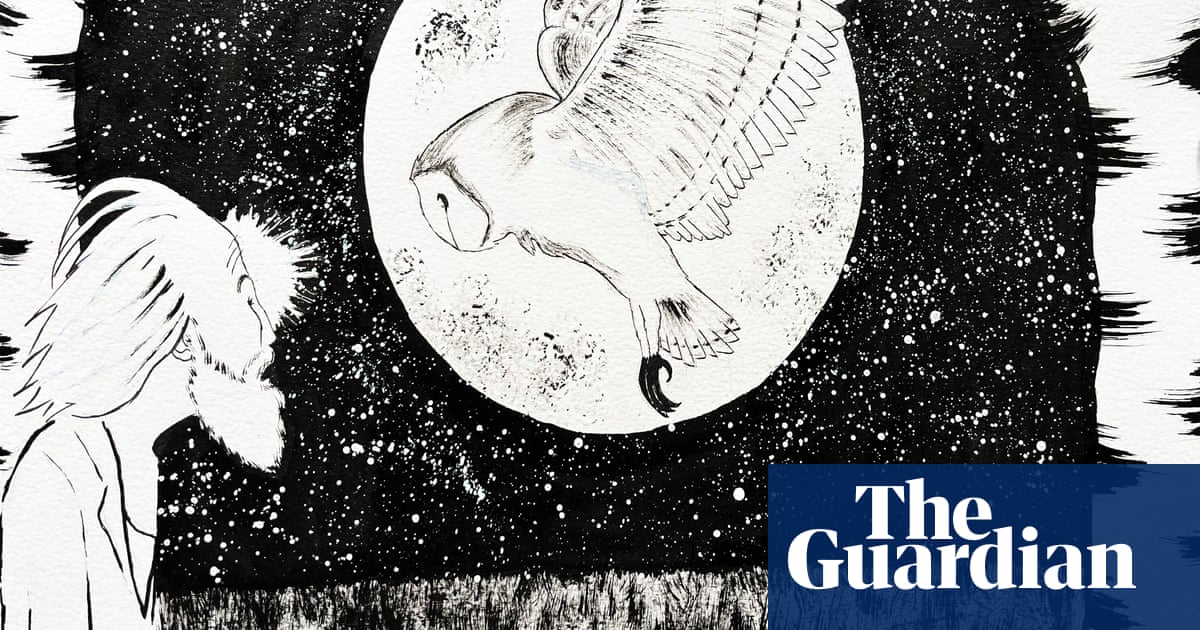Nest Box
When the drunken old foolsaw the barn owl,
he swore blind it was an angel.‘Half-human, half-eagle,’
he told someone in the town square.‘White flames in mid-air,
a ghost with wings,’ he crowedto the gathering crowd.
‘A weird presencethat materialised out of the heavens,’
he said to the scrum of reportersbefore he keeled over.
They searched the meadow and heathbut found only pellets of small bones and teeth
and skulls and part-digested furand knotted hair.
Which was strange, because when the young girlsaw the angel she swore blind it was a barn owl,
but when birdwatchers went to the copseand looked in the nest box
they found tinselly silver threadsand luminous turds
and a warm meteoriteand a few feathers made only of light.
Nest Box is from Simon Armitage’s Dwell, a slim hardback collection illustrated by the talented Cornish artist and printmaker,Beth Munro.
The briefly titled poems, such as Drey, Den, Hibernaculum and Insect Hotel, focus on the safe places, natural or devised, inhabited by the wildlife of the restoredLost Gardens of Heliganin Cornwall. Eventually, we’re told, the poems will be “manifested physically at site-specific locations and in different guises” – as installations, treasure-trails, sculptures and so on. Dwell, therefore, is an illustrated print preview, an informal, engaging, often humorous short collection that will appeal to younger readers, and occasional readers, and sharpen every reader’s ecological conscience.
The Lost Gardens project, today and in its future planned restorations, has supreme ecological significance, as Dwell makes clear. It’s a story with major historical-political dimensions, too, concerning class, regionalism, and the first world war. I’m already speculating, and hoping, that a full-length collection might emerge later from the poet laureate’s heartfelt engagement with the “Willow Garden” (as its Cornish name translates). It is rich material.
While the poems in Dwell are simultaneously grounded and freely imaginative, Nest Box addresses more fundamental questions about what we define as real. It reminded me, on a first reading, of similar questions raised by one of my favourite children’s books, Skellig, by David Almond. There, the eponymous protagonist might almost be any homeless man, but, as he eventually admits to the children who have helped rescue him, he’s really “something combining aspects of human, owl and angel”. Almond acknowledges the influence of a short story by Gabriel García Márquez, A Very Old Man With Enormous Wings, usually classified as magic realism.
Armitage’s poem is more oblique: not contained easily in any genre box, it’s essentially concerned with questioning the human response to natural phenomena, and asking how we can provide “evidence” to challenge our possible illusions. There is an ecological force to the inquiry: humans need some enchantment to draw them into a less than self-centred concern with the environment, but we need to know what we see when we see “nature”, to best be able to preserve it. It’s a big question for ecopoets, too.
Nest Box begins when the “drunken old fool” (or supposed one) swears “blind” that he saw an angel in the sky. He burbles a riff of conflicting images: “half-human, half eagle”, “white flames in mid-air // a ghost with wings”. The reporters investigating the story, after the man has “keeled over”, search for evidence, but find only the remains of an owl’s last meal.
Armitage’s narrative, casual but determinedly objective, pursues the qualifications of rhetorical argument, the “strange” and the “but then”… A second observer, a young girl, swears her own sighting to have been a barn owl. But are the two visions incompatible? The evidence for the sighting of the angel consists of the remains of small mammals (“pellets of small bones and teeth, // and skulls, and part-digested fur / and knotted hair”). The evidence for the barn owl is pursued by birdwatchers, a breed of narrator we’d expect to be less unreliable than reporters. They check the nest box and find a mysterious, mixed assemblage: “tinselly silver threads / and luminous turds // and a warm meteorite / and a few feathers made only of light.” Are the angel and the owl sharing the nest box by any chance?
There are lively if not unpredictable “turns” as Armitage’s fast-moving, rhymed and half-rhymed couplets unroll, blending journalese and lyric tones. No adjudication is imposed: ultimately, the evidence for the nest box angel may be as unreliable as the old drunk’s sighting of the creature itself. The young and not-so-young reader’s imaginative intelligence is well-nourished. What evidence, we wonder, would show that an angel had used a nest-box meant for an owl? What is an angel? What is this one like? It’s clearly not a grumpy old man with wings, and not as grand and strange as what was seen by the “drunken old fool”, either. It’s an angel the size of a barn-owl, or smaller. Should we think of Thomas Aquinas’sSumma Theologica? Perhaps it’s not any traditional kind of angel, but, in view of the “warm meteorite”, not essentially supernatural. The muscles of ratiocination and imagination need to be continually exercised by us earth-dwellers, not least because life-forms on planets other than ours are almost certain to be discovered one day soon.
Armitage’s “Welcome Note” to Dwell is relevant to Nest Box. He describes how his grandparents fought to guard the eaves of their proudly well-maintained council house against messy nesting house martins. “This kind of inhospitality,” Armitage writes, “has increased in direct proportion to soaring human populations, and the consequence of homelessness for most living things is extinction. House martins are now a red-listed bird.” It’s something to bear in mind as we enjoy the magic and humour of the angel-owl but ponder the last traces of its residency in the well-meant nest box.
Dwell by Simon Armitage, illustrated by Beth Munro, is published by Faber & Faber, priced £10. To support the Guardian, order your copy atguardianbookshop.com. Delivery charges may apply.
